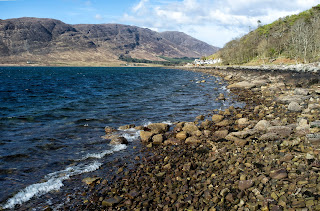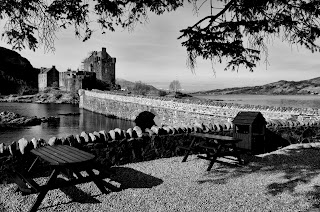Fuji X100 Compact Camera
I've had my Fuji X100 since Christmas of 2011 and it's the longest time I've kept a digital camera without upgrading. I've gone through a number of digital compact and SLR cameras from a Minolta 7D, Canon 30D, Canon 50D with L glass, Canon G9 and a Panasonic LX5. All have been sold to fund newer models, one of which was the Fuji X100. I also have a Pentax K5 which is the best SLR I've owned but that's for another time.
This has been my favourite camera of all the models I've owned and simply couldn't bear to sell it. Why? Well read on and I'll attempt to tell you why this is the perfect companion for travel photography.
 |
| Applecross Bay |
The Camera
The Fuji X100 is a digital compact camera built around a 12MP APS-C sensor sporting a fixed 23mm lens (35mm in full frame terms) and comes in a classical range finder styled metal body. One thing you'll notice when you birth the camera from its plush presentation box is the feeling of sheer quality. The metal body and dials (shutter speed and exposure compensation) all exude an air of precision engineering and hark back to the days when this quality was the norm. The dials all have satisfying clicks although the fiddly back button within the jog wheel could be a little larger if you're fat fingered. With the latest Firmware you can customise the top Fn button and rear RAW button to a number of different functions. I tend to leave Fn linked to ISO and the RAW button to switch on the built in neutral density filter.
 Its when you start viewing images that you realise what an outstanding camera Fuji have created. JPEGs straight out of the camera are beautifully lush and sharp with colours that only Fuji seem to be able to produce. Fuji have always been renowned for their film emulsions like Reala and Velvia and this knowledge has been ported to the X100; I've simply not seen images like this from any of the cameras I've previously owned. This is the main reason I've not sold my X100, the image quality on occasion is breathtaking and sweeps the floor with anything I took with my Canon 50D and L glass.
Its when you start viewing images that you realise what an outstanding camera Fuji have created. JPEGs straight out of the camera are beautifully lush and sharp with colours that only Fuji seem to be able to produce. Fuji have always been renowned for their film emulsions like Reala and Velvia and this knowledge has been ported to the X100; I've simply not seen images like this from any of the cameras I've previously owned. This is the main reason I've not sold my X100, the image quality on occasion is breathtaking and sweeps the floor with anything I took with my Canon 50D and L glass.Hybrid Viewfinder
Newer Fuji models have adopted the Hybrid Viewfinder that is used on the X100 but this was the first to implement it. With a flick of the switch located on the front of the camera you can choose to have either an optical viewfinder or an electronic viewfinder. Using the EVF overlays full shooting information over the scene you are looking at including f-stop, horizontal level, shutter speed, DOF, film simulation, flash status, histogram and exposure compensation. Having the histogram and exposure compensation displayed over your scene is incredibly useful preventing you from taking a shot and viewing the data or composing using the LCD screen. Personally I prefer the optical view as it is clearer but being able to switch between the two is a great development on Fuji's part.
 |
| Eilan Donan Castle |
If, like me, you come from a background of shooting film then you'll appreciate the X100's top panel dials. There are two dials, one for selecting shutter speed (or set to 'A' for aperture priority, remember those days?) and one to under or over expose. These, coupled with a programmable Fn button, combine to make shooting a pleasure and negate the menu diving you get with some cameras. Set the Auto ISO, switch to aperture priority and you won't need to look at menu when you start composing your shots. The rear panel has a small jog wheel and this is probably the weakest point of the whole design. Pressing the small inset button inside the jog wheel needs precise pressing and isn't good if you're a masher. It's adequate and that is about the best I can say but once you get used to it, it doesn't grate too much. Both the Fn button on the top plate and the RAW button on the rear can be customised with a number of preset functions. It's not as customisable as an SLR but then again this isn't an SLR and shouldn't be critically compared too much. Once you are familiar with the layout of the buttons and menus then the X100 is quite intuitive to use.
Image Quality
Image quality is where this camera excels and the combination of Fuji's optics, the sensor designed specifically for the camera and the colour rendition create fabulous photographs. The lens is fixed at a 35mm equivalent but I haven't found this to be restrictive at all, in fact, it makes you ponder and analyse your composition better than just zooming in and out. I've been into photography for 25 years and started out with an OM10 and 50mm so I'm used to fixed focal lengths.
I've previously owned a few SLR cameras and the last one I had was a Canon 50D with a 17-40 lens. I used it once on a trip to Slovenia and wasn't impressed. The image quality of the X100 outstripped the Canon by a long way and now I have something much more portable that I can carry with me all the time. It's a camera I still get a buzz about using and I'm always genuinely excited when taking photographs as I know I'll be wowed when I final get them back to the PC.
What you notice is the beauty of the colours; they have that indefinable Fuji look which are contrasty and saturated (not overly) and have a real 'pop'. I have always shot in RAW but have found OOC JPEGs nail it pretty much every time so now I only take RAW when I have something special in front of my camera.
Images are sharp with very little distortion and if you shoot JPEGs anyway there is in camera adjustments for any distortion or peripheral illumination. You have a choice of film type from Fuji's film days; Velvia for lush landscapes, Provia for standard colours and Astia which gives pleasing skin tones. For travelling I usually have it on Velvia for nice saturated greens and blue skies.

No comments:
Post a Comment